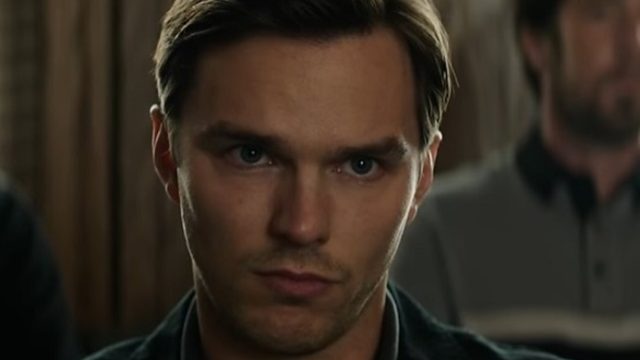Note: This review discusses the entire plot of Juror #2.
“It thrives on neglect,” Chris Messina’s public defender tells Toni Collette’s newly-elected DA as he drops a plant off in her new office toward the end of Juror #2. A good gift for someone who’s likely going to be otherwise occupied as they work hard on behalf of The People, deciding who to prosecute and what punishment to demand. A person whose job is to uphold justice, and isn’t that what our system of trial by jury asks of us all? To be part of justice? Juror #2 suggests that system — “flawed, but the best we have,” as a judge says — and the people who participate in it thrive on neglect as well. On looking the other way.
In terms of neglect, screenwriter Jonathan Abrams has come in for more than his share. Obviously director Clint Eastwood is going to get a lot of attention, especially considering Juror #2 may be his final film (although not if Eastwood can help it, one imagines), but Abrams’ script has been generally if genially dismissed as a “potboiler,” one that thrives on contrivance. And the plot indeed turns on a fairly improbable act, that Nicholas Hoult is placed on a jury weighing the guilt of a man accused of a killing that Hoult (almost certainly) committed himself. But a man investigating a crime he committed is a great pulpy plot, the cynical journalism noir Scandal Sheet uses it particularly well and borrowing a setup from Sam Fuller is always a good idea. It’s easy to believe something improbable if not impossible in the early going of a story if the resulting actions themselves are plausible. This is where Abrams and Eastwood pay off the premise, by following a man forced to act in public while maintaining secret motivations, a man who has everything to lose in his life and fears he could also lose his soul, who wants more than anything to tend his own garden and go back to neglecting the rest of the world.
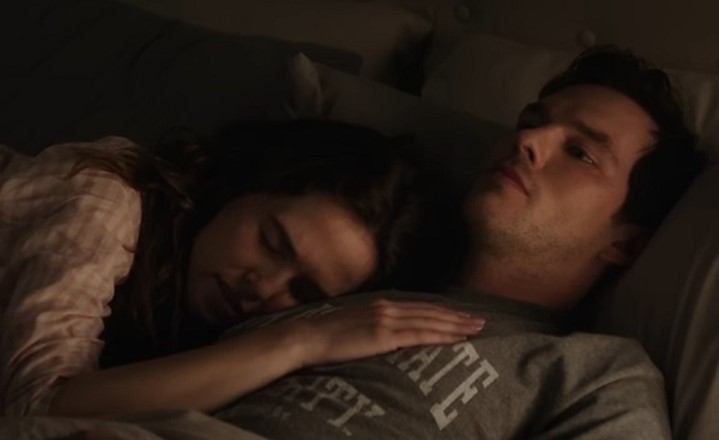
The real implausibility in Abrams’ screenplay is that Hoult seems entirely unaware of the trial before he’s called in for jury duty. It’s a high-profile case that Savannah ADA Toni Collette is hoping to ride to higher office via an aggressive prosecution doubling as campaign material for an upcoming election and the particulars are juicy — no one denies that Gabriel Basso and Francesca Eastwood (yes, Clint’s daughter) got into a fight about their relationship at a local bar, with Eastwood ultimately storming out into the rain and Basso leaving shortly after, and Eastwood’s broken body discovered in a nearby ravine the next day. Somehow Hoult, a magazine journalist, hasn’t followed this in the news — perhaps because he’s distracted by wife Zooey Deutch’s pregnancy after years of trying for a child — and only hears the facts of the case in opening arguments. And realizes that these aren’t all the facts at all.
Because, in the first of several flashbacks, we see that Hoult was at the bar that night, a glass of whiskey in front of him. And he was driving home through the storm when, distracted by Deutch calling him, he hit something by a bridge next to that ravine. Whatever he struck isn’t there when he gets out of the car to look — he’s no hit and run driver, he’s not a monster — at least not in the road, and it’s too dark to see the bottom of the ravine. Hoult sees a DEER CROSSING sign nearby and he decides that must have been what he hit. What he had to have hit.
Hoult has a somewhat narrow face, one that can be warm but also watchful — he resembles Adam Scott in nonthreatening nebbishness and in how there can be something sinister behind the nerd front. But however much his drawn mouth tries to conceal, his wide eyes give away, and his expression as he realizes his complicity in this early scene is remarkable, clearly guilty to the viewer while still holding enough in reserve to not draw attention from the courtroom. (His puking in the bathroom afterward does prompt concern from a fellow juror, but in the first of many elisions Hoult claims to be disturbed by the photos of Eastwood’s body — as well he may be.) Throughout the movie Eastwood watches those eyes, their panic and maneuvering and real pain. The windows to the soul show a house divided.
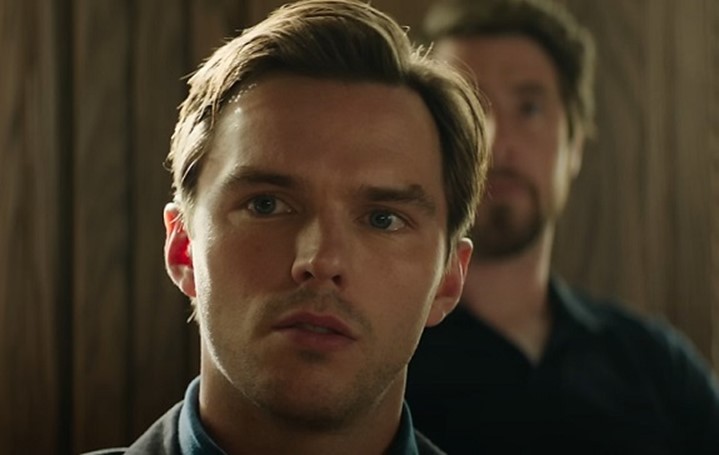
What Abrams has done here is create a true dilemma. Hoult is a decent man who honestly had no idea what he had done until this moment. So what does he do now? He could go to Collette and admit what he knows, and save an innocent man from a horrible fate. But that would make him a killer, however unintentional, and surely separate him from his wife and soon-to-be-born child. And there are other factors. Hoult brings his guilt to his Alcoholics Anonymous sponsor, Kiefer Sutherland, and Sutherland points out that while Hoult insists he was sober, previous years of drinking and history of DUIs will lead officials – especially ones like Collette, who are seeking to burnish their tough-on-crime reputation – to charge him with drunk driving if he admits to hitting someone on his way home from a bar. There’s no way he won’t spend decades in jail.
Sutherland can say this with conviction because he is a defense attorney, a private one. And before he gives this advice — before he even listens to Hoult — he tells Hoult to give him a dollar. That way Hoult has hired him and they have attorney-client privilege. The ability to keep secrets. Collette is an agent of the state but so is Messina’s public defender, besides being former students together and friends they are equal parts of a legal system that is supposed to productively clash in the name of the people, although Messina is overworked and Collette may be trying cases based on how many votes they get her. Sutherland is a warm and friendly guy, and it takes a while to realize that Hoult has bought into a bargain with him. Sutherland’s stated philosophy at an AA meeting is openness and honesty but with his client in their private get-togethers, away from the group settings of AA and the jury room, he advocates silence and denial. He is not a devil on Hoult’s shoulder but he is the opposite of a moral conscience — while his concern is real, he’s still a concern troll of real concern, telling Hoult what he is most afraid of hearing.
One of the things he tells Hoult is that a mistrial will just place Basso back in the court system for some other jury to convict, which will hardly assuage Hoult’s conscience. No, what is needed here is a full Not Guilty verdict. The trial itself does not take up much time in the movie, although Abrams and Eastwood again use flashbacks to show different perspectives on the confrontation at the bar, facts generally the same but intensity and tone differing depending on the teller. Basso takes the stand to make his case — a dangerous move for any accused killer — and Collette contemptuously dismisses his professions of love. Eastwood cleverly intercuts the closing arguments from her and Messina, each statement from one contradicting the other, creating two narratives that Hoult and his fellow jurors must choose from.
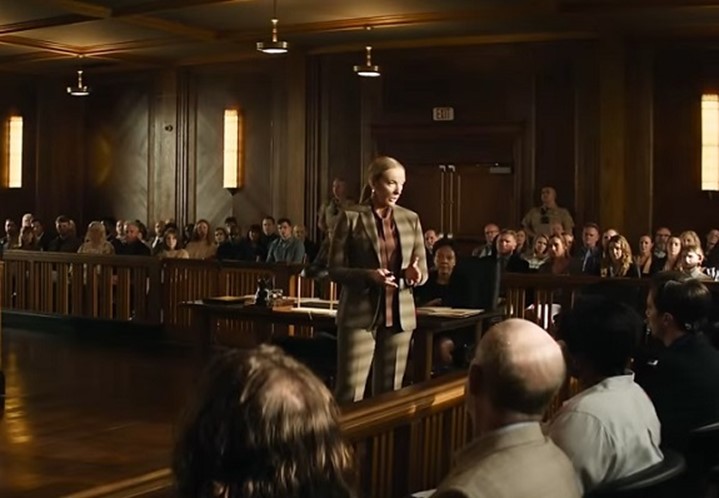
And 11 of them are immediately ready to choose guilt, so Hoult has his work cut out for him. The obvious comparison point here is 12 Angry Men and Eastwood even restages a shot from that movie in the early going, of the lone holdout staring through a window’s blinds — but Hoult’s eyes are not Henry Fonda’s righteous baby blues. Fonda argues out of a desire for truth and decency, he’s sort of a drip in this regard — Hoult is prodding and pushing to find a balance of saving Basso’s skin and his own and trying not to let on that he’s doing this, and it is fascinating to watch him walk this line. It’s hard not to get caught up in sympathy for a decent guy trying to get out of a jam, especially if there’s a way for him to not let someone else take the fall. To see through the eyes of a guy trying to see a way for no one to get hurt. Well, no one else.
Several of Houldt’s fellow jurors also have parallels to those in Lumet’s film, like an older person with quiet authority, a no-nonsense foreperson, a slacker who is all for going home, and especially Cedric Yarbrough, a riff on Lee J. Cobb’s ferocious advocate for guilt. While other jurors are convinced by Collette’s (admittedly strong) case and their own wish to be done with this work, Yarbrough has a personal reason for wanting Basso behind bars — he recognizes one of Basso’s tattoos as an affiliation with the same drug-dealing gang that killed his younger brother. A guy like Basso doesn’t change, Yarbrough says — even if he’s not guilty of this, he’s still guilty. He needs to pay for the things he’s done. Late in the movie, as the jury has deadlocked and Hoult may yet sway the rest, Yarbrough quietly explains his immovability and in a wonderfully understated but implacable shot he shifts his head and the afternoon Savannah sun catches his eyes. It is hard to say which glare is harsher. Yarbrough sees only guilt, and what he sees is not even there.
Yarbrough, Hoult’s strongest opponent, is a black community organizer seeking to put a man in prison for the rest of his life. Hoult’s strongest ally in insisting on Basso’s possible innocence is JK Simmons’ retired white cop. Eastwood and Abrams are clearly enjoying some cross-ups here and with other jurors — a woman is introduced as a true crime podcast fanatic and gets a lot of laughs for her self-proclaimed expertise but she has some real insights; two young would-be wokesters use Basso’s appearance to condemn him as an abuser, you can practically see Eastwood’s smirk — but Simmons’s interest in justice clearly stems from that professional background. He knows when a case is strong and this one is not, and he quickly theorizes Basso is not the culprit (Hoult relaxes) and that a hit and run is more likely (Hoult starts sweating). In terms of action, Simmons is the real Fonda analogue here, going out to look at the crime scene and pulling body shop records of cars that reported significant damage around the time of the death. He attempts to bring Hoult into his investigation and mentions that Hoult’s car turned up on his list of damaged vehicles — jovially and innocently telling the culprit we can cross that one off, at least! Hoult panics and “accidentally” alerts the court to Simmons’ extracurricular activities and he is bounced from the jury immediately, just like that wiener Fonda should’ve been. But his enthusiasm for the hit-and-run culprit has infected other jurors.
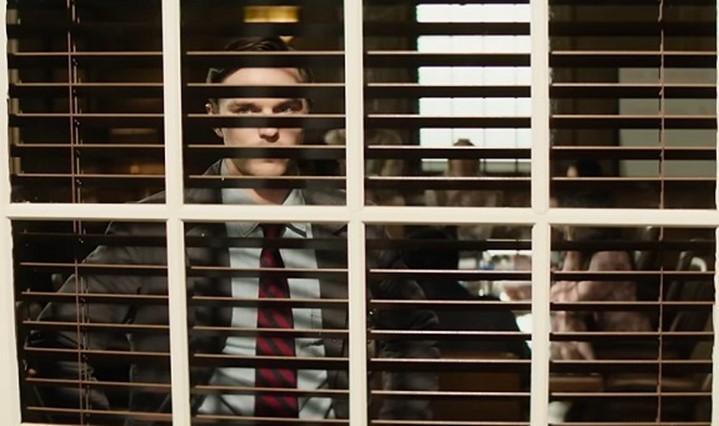
Simmons reveals his cop credentials to the jury in another 12 Angry Men reference, tossing his badge (instead of a blade) on the table. He’s quite rightly asked how the hell he got put on the jury with that background and his response is straightforward: He was never asked about it. Which Abrams and Eastwood have already shown us — during jury selection Messina learns Simmons has retired to Savannah to start a florist business and doesn’t ask any further questions. More neglect, from a public defender who didn’t take that extra step and from Simmons for being willing to lay back and see where this goes, despite knowing this information would be extremely important for either lawyer to know. But his curiosity sparks actual action that is in itself neglected, at least at first. Dismissed from deliberations — and agreeing with that decision while clearing Hoult of any involvement, keeping him in on the jury — Simmons passes his list of suspect vehicles onto Collette, who wants nothing to do with it. And why should she? She has her case. But even though she dismisses him, she now has doubts. She can’t unsee the evidence she’s been given.
As the jury starts to truly consider Basso’s potential innocence — Chikako Fukuyama has a nice small part as a med student with the expertise to cast a skeptical eye on the medical examiner’s ruling that a person did the damage to the victim’s body — Collette revisits the case. On her own time, of course. Just as Simmons discovered his information and Hoult gets legal and moral advice outside the official system we have to determine justice, she pursues the new evidence with the authority of an ADA but without actually adjusting her stance that Basso should be sent to prison for the rest of his life. She talks to the one eyewitness — who the viewer knows actually saw Hoult after his crash, not Basso — and in shades of the shoddy investigation in Mystic River, learns the cops approached him already with their favored suspect in mind and led him into agreement. And she starts running down those cars Simmons found, asking their owners just what happened to cause that damage. She tracks one to the door of its registered owner, a young woman who is heavily pregnant and exhausted but is not so tired she can’t figure out that Collette is asking about the case she’s prosecuting, and that her questions about the car’s damage don’t align with her husband’s story that he hit a deer. Zooey Deutch did not take Hoult’s last name when they got married, so Collette doesn’t make the connection to the juror on her case. But Deutch is making connections of her own.

The smartest aspect of Abrams’ screenplay is how it reveals information. During the trial, it contrasts depictions of the fatal night without truly contradicting them, but showing how the person describing what they saw might emphasize or edit things based on their preconceptions and prejudices. And while it does not reveal a twist or a new action beyond Hoult’s first flashback, the thunderclap of understanding that kicks off the plot, it continually peels back the editing Hoult has done for Deutch and for himself. Hoult is already straining their relationship as he stays out late trying to figure a way out of his increasingly desperate situation and then lies to Deutch about where he’s been, leading her to be suspicious of what he’s really up to. After Collette questions Deutch, she confronts Hoult — where did you really get into an accident? What were you doing there? And Hoult flashes back again, but this time it’s more fleshed out.
The viewer now understands Hoult was at the bar following Deutch’s miscarriage, in a state of total despair. That’s why he ordered a whiskey despite years of hard-earned sobriety, that’s why he stares at it while Basso and Francesca Eastwood loudly argue behind him, paying no attention to their conflict. But he doesn’t drink. He leaves and gets in his car and sobs for a bit, but he is sober as he drives home. And, distracted by his wife calling to find out where he is, hits something. Watching this, I was worried Abrams would show Hoult had actually taken that damning drink and was thrilled to see he didn’t take that easy out, and then less comfortable thinking on the implications. A drunk driver would deserve to face consequences for his actions, Hoult resists a dark temptation and still winds up as a killer because he merely considered it. Like the man once said, deserve’s got nothing to do with it.
As Hoult explains this to Deutch, he’s in their dark garage, and while the jury room is well-lit and comfortable (as opposed to the sweatbox of 12 Angry Men) his home has consistently been cast in shadow since the trial began. Darkness covers most of his face but in a stunning shot from Yves Bélanger his eyes remain in light, staring and wide and yet not open, not in the sense of being honest. Because while he explains to Deutch that he went to the bar and very nearly relapsed, he insists that he really hit a deer, and that he did so on a different road. Those eyes plead for belief and Deutch decides not to disbelieve. Which is not the same thing. The movie opens with images of Blind Justice before cutting to Deutch’s blindfolded face, Hoult has covered her eyes for a big reveal of their coming child’s nursery. It’s a somewhat eye-rolling match that is paid off here, as Deutch makes the choice not to see what is there. To leave things as they are for the sake of her family. They can thrive or at least survive on neglect.
Abrams’ screenplay has one final reveal, as the deadlocked jury is taken to the scene of the crime and Hoult once again flashes back to the night at the bar. While Hoult is clearly in possession of important information and almost certainly killed the victim, Abrams leaves the door open that Basso did this after all — a big factor in the case against him is how no one saw what happened after he went for his car to follow his girlfriend. But back at the bar for the first time since that night, Hoult flashes back to sobbing in the car before driving away — and passing Basso heading in the other direction. Something meaningless at the time that means everything now. His guilt is affirmed at the same time that Yarbrough lays down his immutable belief in Basso’s own guilt. Hoult has twisted back and forth throughout the movie, trying to find a way to thread the needle of no one going to prison for this woman’s death, and now he is out of maneuvering space. And the next day, the jury reads its verdict: Guilty. But Hoult’s seat is empty. He’s at the hospital with Deutch, holding his new daughter in his arms. He’s not in court to see what his neglect to come forward, his choice to say he now sees Basso’s guilt, has done.
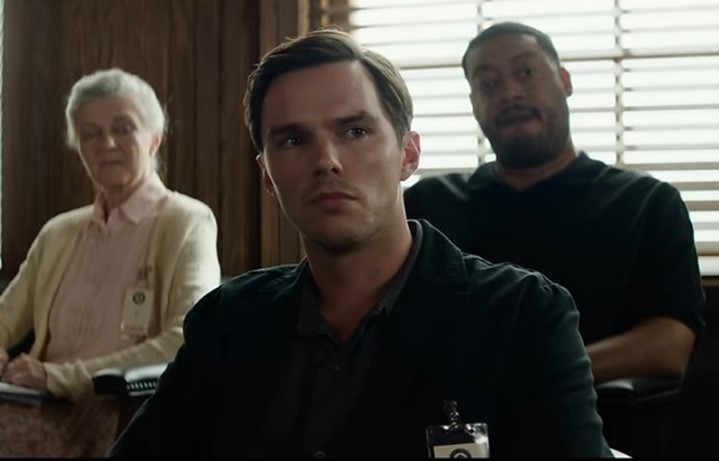
This is a victory for Collette, of course, and winning the election and getting that new office (and plant!) is a distraction from any lingering doubts. But at Basso’s sentencing, the different names of the father and mother on a congratulatory card from the victim’s family causes a click in her mind about that man who told his wife he hit a deer, and who he really is. She meets Hoult outside the courthouse and once again the halls of justice are not where truth is being uncovered. Where the facts of a man’s guilt are being weighed. Because an innocent man is now in jail — but how innocent is he, Hoult asks? Basso was a gang member and quite possibly an abusive boyfriend. His imprisonment might be what’s best for society, and his conviction certainly was good for Collette. Tearing down his conviction would tear down her career. And it would tear down the life of a good man, a man who worked so hard to be a good man, who has a wife and a baby to take care of. Better to let this lie.
Jonathan Abrams wrote Juror #2 and Clint Eastwood directed it, and what Eastwood really brings is a sense of life how it is lived – the boring video explaining civics to the new jury, the ice creams Sutherland gets at the park, the dorky friends of Hoult and Zooey who come to their engagement party – and how that life for Hoult increasingly depends on looking the other way. But the person who has most defined the movie’s existence in the world is Warner/Discovery head David Zaslav, who only put it in theaters for a week and change. Zaslav is a sneering dunce who acts as a dunce does – destroying and degrading things solely because it (slowly) occurs to him to do so and because he can – and it is unfortunate that his dull indignities command so much attention. There is nothing to neglect for the person too blinkered and stupid to see and it’s not worth considering such a person. Juror #2 — and Eastwood as an artist — is concerned with something more complicated and fraught than pointless destruction: what it means to look at your actions in the world and what it means to look away. Because while the world is shaped by what we do and see, it ultimately doesn’t care, and the institutions we build have their own mechanistic indifference. There is no justice, Terry Pratchett has said. Just us.
Hoult sells the car, getting rid of the only evidence tying him to the killing. He sits with his wife and daughter, who the doting parents note has his eyes. And Hoult the actor shows something that he has strategically withheld all movie — true happiness. He looks at his family with the eyes of a man who is truly seeing the beauty of his life, a man who is seeing a joyous present stretching into a glorious future with nothing in the past to haunt his vision. But then the doorbell rings and Hoult opens the door on Collette. She does not say a word but in her gaze is the clarity of someone who has belatedly but firmly made the choice not to look away, and what she is looking at is Hoult. Hoult looks back and Eastwood cuts to the credits, refusing to render a verdict — the people behind me at my screening were audibly upset. I don’t think Eastwood and Abrams are cheating the audience, though. The last thing we see is Hoult’s eyes, looking at Collette and also us, and what I saw in those eyes was fear and guilt and understanding, a man’s refusal to give up what he has and admit what he did to get it but recognition that neglect is no longer an option. I wonder what he would see in mine.

